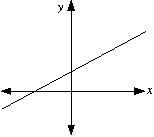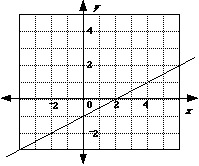1. C = {(2, 5),(4, 9), (6, 13)} is a function.
(a) List the domain of C.
(b) List the range of C.
2. Complete the ordered pairs for the given relations:
(a) y = x − 3 {(0, ), (1, ), (-1, ),(-2, ), ( , 0), (n, ), ( , m)}
(b) y − 2x = 6 {(0, ), (1, ), (-1, ),(-2, ), ( , 0), (n, ), ( , m)}
(c) y = x 2 + 3 {(0, ), (1, ), (-1, ),(-2, ), (n, ), ( , m)}
3. Which of the following relations are also functions?
|
(a) |
(b) |
|
(c) |
(d) |
4. D = {(-2, 4), (-1, 1), (0, 0),(1, 1), (2, 4)}
(a) Show this relation:
(i) As an arrow graph.
(ii) As an (x, y) graph.
(b) What is the equation for this relation?
5. For the relation shown:
|
(a) List the domain. (b) List the range. (c) Is the relation shown also a function? (d) Write the relation as a set of ordered pairs. |
|
6. Give the equation of the following relations:
(a) {(2, 4), (3, 9), (4, 16)}
(b) {(1, 0), (2, 1), (3, 2)}
(c) {(0, 1), (1, 3), (2, 5)}
7. (a) Rectangles each of width 1 unit are outlined with matchsticks as shown below.
![]()
Complete the pattern of numbers in the top part of the table and use the pattern to fill in the lower part.
|
Number of matchsticks along each long side |
Total number of matchsticks |
|
1 |
4 |
|
2 |
6 |
|
3 |
|
|
4 |
|
|
5 |
|
|
42 |
|
|
n |
|
|
42 |
|
|
m |
(b) The line drawn below is the graph of the function y = 0.5x − 1
On the same diagram, draw:
|
(i) The line with equation y = x (ii) The line that is the graph of y = 2x + 2 |
|





